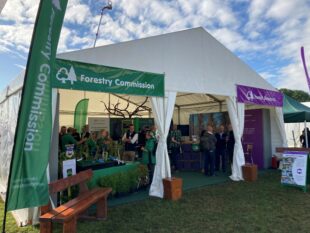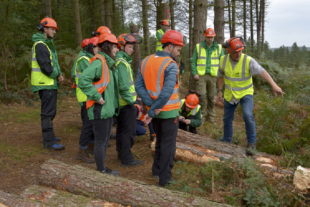 Emily Robinson, Content Officer at Forestry Commission, looks at four mammals that contribute to forest ecosystems and discusses how balanced woodland management can support both wildlife conservation and forestry objectives.
Emily Robinson, Content Officer at Forestry Commission, looks at four mammals that contribute to forest ecosystems and discusses how balanced woodland management can support both wildlife conservation and forestry objectives.
From the nocturnal flights of bats to the stealthy movements of pine martens, our woodlands host a rich tapestry of mammalian life. These animals – some common, others rare and elusive – form intricate relationships with the trees around them, becoming part of a woodland’s living story.
In this blog, I explore four influential woodland mammals, consider how their presence shapes our forests and how careful management can ensure they continue to thrive alongside healthy trees.
1. Hazel dormice

With their golden-brown fur, large black eyes and bushy tails, these tiny mammals are arboreal (tree) specialists well-adapted for life among branches. Their diet shifts with the woodland calendar; eating spring flowers, summer insects and autumn nuts and berries. Hazel dormice aid in seed dispersal of hazelnuts, helping woodlands to regenerate.
Dormice can spend more than half the year in a state of torpor or deep sleep, like hibernation, usually in nests among tree roots or in leaf litter. When active, they prefer to travel through a connected canopy of woodland trees. You can find them in old coppice woodland and sometimes conifer plantations, though spotting them is rare, as sadly their numbers have declined.
The loss of ancient woodland and hedgerows coupled with a lack of management of those that are left has contributed to their decline, leaving populations isolated and at risk of losing genetic diversity. They fare better under traditional woodland management techniques like coppicing which allows light to reach the woodland floor, helping the understory to grow. Creating wildlife corridors also allows them to move from one woodland to another, increasing access to food sources and nesting sites.
2. Stoats

Moving with speed through the undergrowth, stoats represent the woodland’s middle-order predators. These slender, opportunistic hunters take prey larger than themselves, but mainly eat voles, mice and rabbits. While adaptable to various habitats including grasslands and moorlands, woodlands offer an ideal habitat with abundant prey and cover.
Distinguishable by their sleek, elongated bodies (25-32cm in length including the tail) and distinctive, black-tipped bushy tails, stoats can often be confused with their smaller cousin, the weasel. The black tail tip serves as a reliable field marker as weasels lack this feature entirely. Their fur is brown with white underparts, sometimes turning completely white in winter (leaving just the black tail tip) in snowy northern UK regions.
They patrol large territories, helping to keep rodent populations under control. Stoats influence prey behaviour and distribution, for example, rodents will modify feeding patterns and activity times to avoid them. These behavioural shifts cascade throughout the woodland ecosystem, altering vegetation patterns as grazing pressure shifts. Areas heavily patrolled by stoats may even develop different plant communities than those where prey can feed more freely.
3. Bats
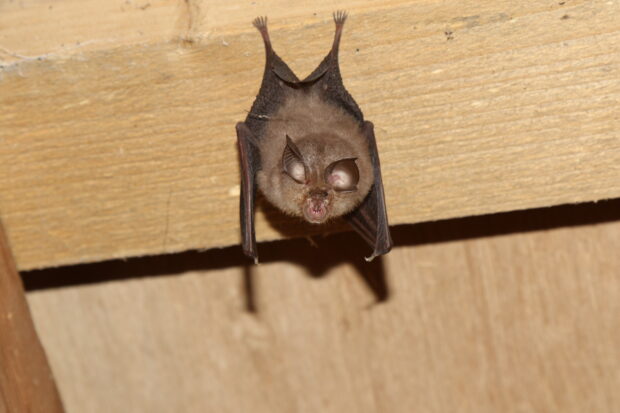
As dusk falls over a woodland, bats emerge from their daytime roosts to begin their nightly hunt. There are 18 species of bat in the UK. Many forage in woodlands and most use trees as roosts. Woodland specialists you may find include Bechstein’s bat, barbastelles and noctules.
Older trees provide vital shelter through features like cracks, crevices and hollows which are used to hibernate, sleep and raise young. Mature woodlands are particularly important for bats, offering the hollow trees and deadwood they need. The complex structure of these woodlands, with their varied canopy heights and open glades, create flight paths and feeding opportunities.
Bats have an important role in managing a woodland’s insect population, each species favouring different insects for food. A pipistrelle bat can eat around 3,000 tiny insects in a single night including midges, moths and lacewings. This natural predation helps protect woodland trees from defoliating insects (such as oak leaf roller moths whose larvae remove leaves) and maintains healthy insect populations.
4. Pine martens
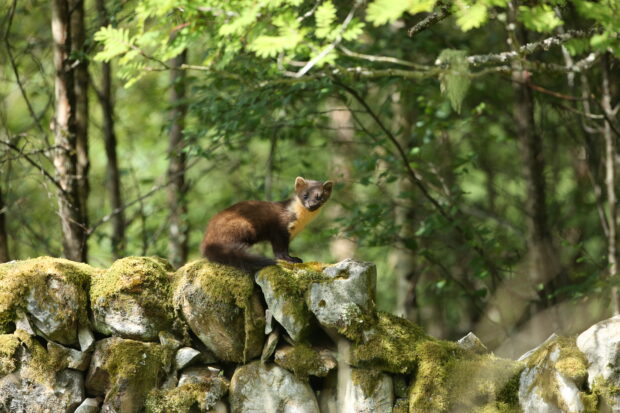
After centuries of persecution and habitat loss, pine martens are making a remarkable comeback in parts of the UK. Pine martens have a diverse diet including small mammals, birds, insects, fruits and berries. Their feeding habits change seasonally, taking advantage of whatever food sources are abundant. This dietary flexibility helps regulate various woodland species, preventing any single population from dominating.
As they keep small mammal populations balanced, they help to limit excessive herbivory that could damage young tree saplings and forest regeneration. Their droppings (or 'scats'), often contain berry seeds in autumn, which also aid in seed dispersal across wide territories.
Research has revealed an unexpected conservation twist: pine martens may benefit red squirrels. Higher densities of pine martens appear to alter the competition dynamic between red and grey squirrels, allowing reds to thrive and suppressing numbers of less adapted greys which appear oblivious to the threat. Natural predation and disturbance of grey squirrels lessens competition for resources and reduces pressure from squirrelpox virus – offering hope for red squirrel conservation.
Mammal damage to trees
While celebrating woodland mammals, it is worth acknowledging that their activities sometimes conflict with forestry objectives. Grey squirrels (and occasionally reds) strip bark from trees, potentially causing damage to timber crops. Voles and mice may gnaw on tree saplings, while larger mammals like deer browse young shoots and leaves.
These behaviours are natural processes that have occurred throughout woodland evolution. Bark stripping creates deadwood habitat beneficial for insects, fungi and cavity-nesting species. Browsing can maintain open areas within woodlands, supporting greater overall biodiversity. Even burrowing, which might occasionally undermine tree roots, contributes to soil health and nutrient cycling.
The problem arises when ecosystems are unbalanced due to lack of predation of certain species and habitat fragmentation limiting the movement of mammals. This is evident in our modern landscapes where natural predators have been removed and woodland habitats exist disconnected among agricultural or urban settings.
Management to benefit wildlife and trees
Managing woodland to benefit both wildlife and forestry objectives requires an integrated approach that balances ecological needs with sustainable forestry practices.
Effective woodland management for mammal conservation requires comprehensive ecological surveys before any forestry operations to identify species presence, habitat use and potential protected species. Timing work outside breeding seasons minimises wildlife disturbance and maintaining diverse habitats with deadwood, varied canopy layers and understory vegetation provides essential resources for trees and wildlife alike.
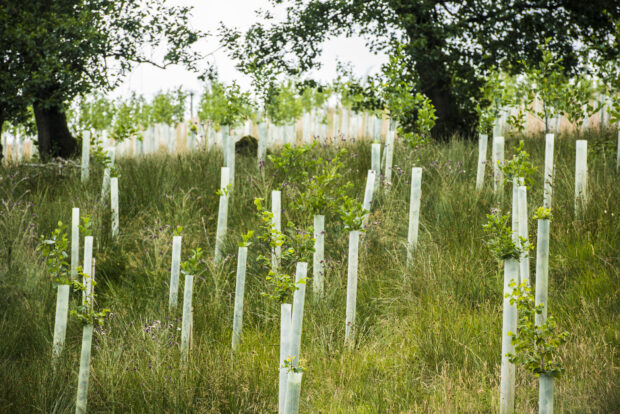
Young trees often require protection from wildlife damage. The Forestry Commission’s Grey squirrel and deer damage visual guide helps identify the cause of tree damage. Tree shelters and guards can be used to protect young trees by deterring small mammals and deer during tree establishment. Additional guidance on How to manage destructive animals and invasive species is available to ensure successful tree growth.
A carefully planned and managed woodland delivers a wide range of benefits beyond supporting biodiversity, including income generation opportunities, carbon offsetting and recreation opportunities. A holistic management approach ensures woodlands remain vibrant, productive ecosystems that serve both wildlife and human needs.
Beyond the branches
Our woodland mammals each fill crucial ecological niches that have evolved over millennia. Their ecological contributions ripple through the woodland, influencing everything from soil health to tree regeneration. As we manage our woodlands for the future, understanding these remarkable animals and their relationships with trees helps us make informed decisions that benefit both wildlife and forestry objectives.
Appreciating these often-unseen mammals adds another dimension to our connection with these precious habitats. These mammals invite us to look deeper than the trees themselves, to understand that healthy forests depend on the countless interactions happening beneath the canopy, behind the bark and beyond the branches.
Learn more about the benefits of woodland creation through our Woods for Nature factsheet.
